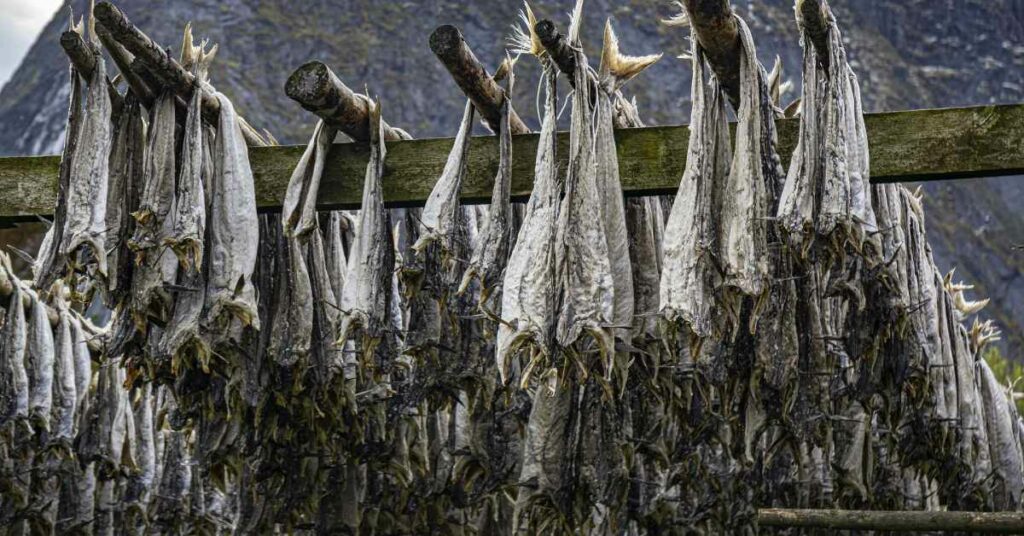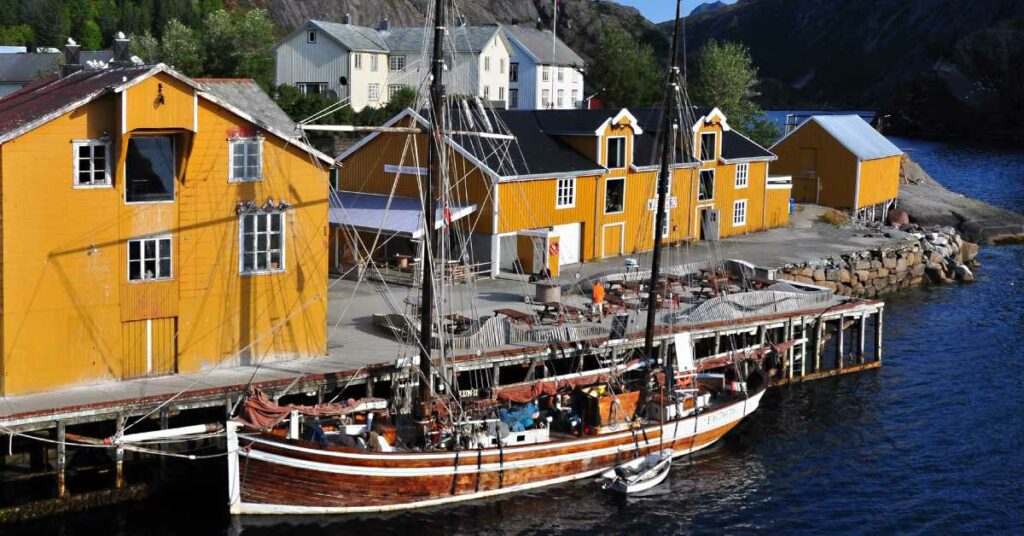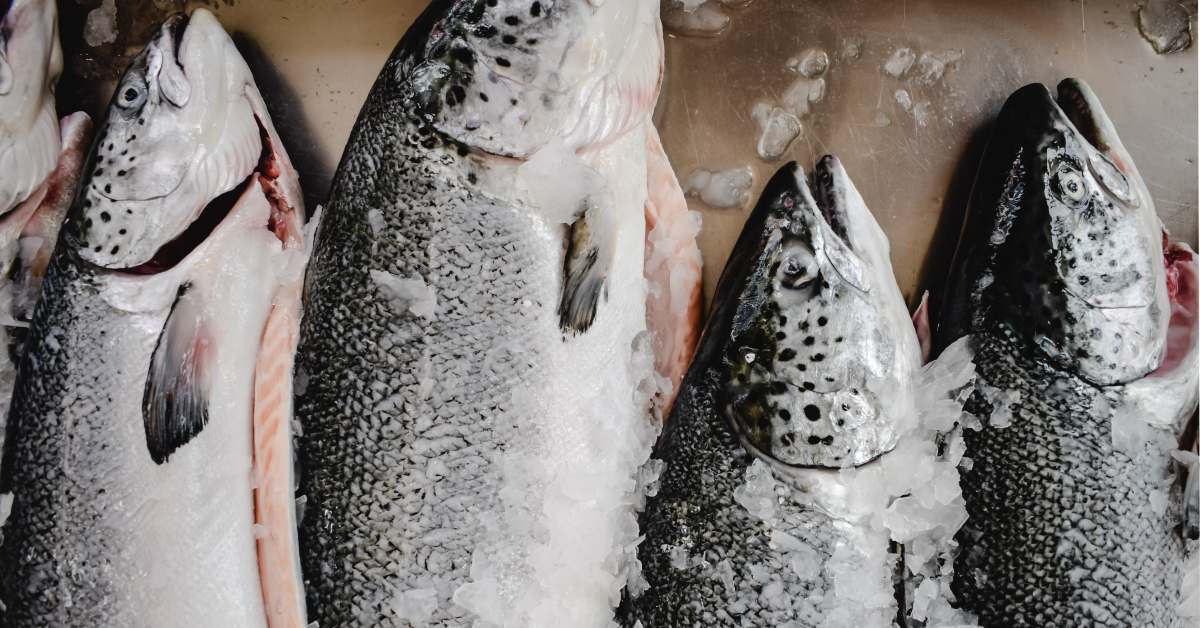It is a common question to wonder about the difference between Norwegian salmon and Atlantic salmon. Or more specifically, in the Norwegian Salmon vs Atlantic Salmon debate, which is “better?”
Within the diverse realm of salmon, Norwegian salmon and Atlantic salmon stand as two prominent representatives, each with distinct characteristics and ecological origins.
The geographical origin of Norwegian salmon lies in the cold, pristine waters of Norway, renowned for their rich biodiversity and optimal conditions for salmonid species. On the other hand, Atlantic salmon, a species distributed across various regions of the North Atlantic Ocean, including Canada, Scotland, and parts of the United States, thrives in a diverse range of ecosystems.
As aquaculture endeavors intensify to meet the rising demand for salmon, both Norwegian and Atlantic salmon have become subject to cultivation practices aimed at optimizing production while addressing sustainability concerns. Understanding the nuances of these farming practices is crucial for comprehending the potential implications on fish quality and ecological balance.
While culinary enthusiasts celebrate the exquisite taste and texture of both Norwegian and Atlantic salmon, scientific analyses have identified distinct differences between the two species. These variations are attributed to factors such as diet, habitat, and genetic makeup, which collectively contribute to their unique flavors and physical characteristics.
Apart from their culinary appeal, Norwegian and Atlantic salmon are esteemed for their exceptional nutritional composition, notably their high content of omega-3 fatty acids, proteins, vitamins, and minerals. These elements have garnered significant attention from health professionals and researchers alike, prompting investigations into the potential health benefits conferred by regular consumption of these fish.
This comprehensive article aims to unravel the multifaceted attributes of Norwegian salmon and Atlantic salmon through an evidence-based and scientifically-grounded approach. By comparing their ecological origins, farming practices, taste profiles, and nutritional compositions, we endeavor to provide readers with a thorough understanding of the differentiators between these two remarkable salmon species.
Through this endeavor, we hope to foster informed decision-making among seafood consumers and contribute to the ongoing discourse surrounding sustainable aquaculture and seafood choices. Join us as we embark on this illuminating scientific journey into the world of Norwegian salmon and Atlantic salmon.
Norwegian Salmon vs Atlantic Salmon: Species and Origin
Salmon, belonging to the family Salmonidae, comprises various species, each with its own unique characteristics and geographical origins. In this section, we focus on two prominent types of salmon: Norwegian salmon and Atlantic salmon, shedding light on their respective species and origins.
Norwegian Salmon General Facts
Norwegian salmon, scientifically known as Salmo salar, is a prized member of the salmonid family, known for its remarkable flavor and rich nutritional profile. As the name suggests, Norwegian salmon originates from the cold and pristine waters of Norway, a country renowned for its majestic fjords, glacial rivers, and well-preserved marine ecosystems. These natural habitats offer the ideal conditions for salmonid species, fostering their growth and ensuring their unique attributes.
Atlantic Salmon General Facts
The Atlantic salmon (also Salmo salar), also known as the “king of fish,” is another distinguished member of the salmonid family. Unlike Norwegian salmon, which derives its name from its place of origin, Atlantic salmon is widespread and can be found in various regions across the North Atlantic Ocean. This includes the coastal waters of Canada, the United States, Iceland, Scotland, Ireland, and parts of northern Europe. The extensive distribution of Atlantic salmon showcases its adaptability to diverse marine environments, reflecting its versatility as a species.
Norwegian Salmon vs Atlantic Salmon: Distinctive Traits and Genetic Variations
Despite their taxonomic classification as Salmo salar, Norwegian salmon and Atlantic salmon exhibit certain genetic variations resulting from their distinct ecological origins. Over time, these subtle differences have given rise to diverse traits, including variations in color, taste, texture, and nutritional content.
Understanding the genetic and ecological distinctions between Norwegian salmon and Atlantic salmon provides valuable insights into their unique attributes and helps appreciate the diverse flavors and qualities these two species offer.
In the subsequent sections, we delve deeper into the farming practices employed for each type of salmon and explore how their environments influence their taste, texture, and nutritional value. By gaining a comprehensive understanding of these fundamental aspects, readers can make informed choices about which salmon variety best suits their preferences and aligns with their culinary and nutritional goals. Join us as we embark on this comparative journey, uncovering the intricacies that distinguish Norwegian salmon from Atlantic salmon.
Norwegian Salmon vs Atlantic Salmon: Farming Practices
Norwegian Salmon Farming
Norwegian salmon farming has earned global recognition for its commitment to high standards, sustainable practices, and technological advancements. In Norway, salmon aquaculture is meticulously regulated, ensuring that environmental impacts are minimized, and fish welfare is prioritized. The farming process typically begins with the hatching of eggs in land-based hatcheries, where environmental conditions are closely monitored to simulate the natural spawning environment. Once the fry reach a certain size, they are carefully transferred to sea-based net pens, located in sheltered coastal areas or fjords.

Norwegian salmon farmers adhere to strict guidelines regarding feed composition and feeding practices. Sustainable sourcing of feed ingredients, including marine-based proteins and oils, is emphasized to maintain the balance of marine ecosystems and prevent overfishing of forage fish. In recent years, the industry has made substantial progress in reducing the reliance on wild-caught fish for feed, adopting alternative feed ingredients and innovative feed technologies.
Furthermore, the Norwegian aquaculture sector places considerable emphasis on disease prevention and fish health management. Regular health assessments, vaccinations, and responsible use of veterinary treatments are standard practices to maintain the welfare of the fish and minimize the risk of disease outbreaks. By implementing rigorous biosecurity measures and conducting continuous research, Norwegian salmon farming endeavors to sustain healthy populations and protect wild salmon from potential pathogen transfer.
Atlantic Salmon Farming
Atlantic salmon farming practices can vary depending on the specific region and regulations governing the industry. Farms may be located in marine net pens, sea cages, or land-based facilities, each with its advantages and challenges. The process of raising Atlantic salmon in aquaculture shares similarities with Norwegian salmon farming, beginning with hatcheries and nurseries for initial rearing before transferring the fish to larger sea-based enclosures.
Unlike Norwegian salmon farming, which predominantly takes place in sheltered coastal areas, Atlantic salmon farms can be found in both oceanic and fjordic environments, impacting the fish’s exposure to natural currents and influences on their physical characteristics.
The feed used in Atlantic salmon farming may also differ based on regional practices and availability of ingredients. Efforts are made to ensure that feed sourcing is ecologically responsible, considering the sustainability of fisheries and minimizing the use of wild-caught fish as feed components.
Norwegian Salmon and Atlantic Salmon: Sustainability and Environmental Considerations
Both Norwegian and Atlantic salmon farming industries face challenges regarding sustainability and environmental impacts. Key concerns include the potential release of effluents and waste from net pens, interactions with wild salmon populations, and the use of marine resources for feed production. The extent to which these issues are addressed varies between different farming operations and regulatory frameworks.
In response to these challenges, the aquaculture industry as a whole is actively researching and adopting innovative technologies and practices to improve sustainability and minimize ecological footprints. Ongoing efforts focus on optimizing feed efficiency, reducing waste, and exploring alternative feed sources to decrease reliance on marine-derived proteins.
It is essential to note that while the farming practices of both Norwegian and Atlantic salmon are continuously evolving, significant strides have been made in enhancing sustainability and responsible fish farming. As consumers become increasingly conscious of the origins and ecological impact of their food choices, the industry is compelled to uphold stringent standards to meet the demands of an environmentally-conscious marketplace.
In the subsequent sections, we delve into the taste, texture, and nutritional attributes of Norwegian and Atlantic salmon, shedding light on how farming practices can influence these characteristics. Through an evidence-based comparison, readers can gain insights into the distinct qualities of these two salmon varieties and make informed decisions about their preferences and dietary choices. Join us as we continue our exploration into the realm of Norwegian salmon versus Atlantic salmon.
Norwegian Salmon vs Atlantic Salmon: Taste, Texture, and Color Differences
Norwegian Salmon vs Atlantic Salmon: Taste and Flavor Profile
One of the most distinctive aspects of Norwegian salmon and Atlantic salmon lies in their taste and flavor profiles, which stem from differences in diet, habitat, and genetic factors.
Norwegian Salmon: Norwegian salmon is celebrated for its mild and delicate flavor, with a clean, buttery taste that is highly favored by seafood enthusiasts. The fish’s diet, predominantly composed of marine proteins and oils, contributes to its characteristic richness. The cold, pristine waters of Norway provide an environment abundant in natural resources, which translates into a subtle and well-balanced flavor profile that appeals to a wide range of palates.
Atlantic Salmon: In contrast, Atlantic salmon is renowned for its slightly more pronounced and robust flavor. The varied environments in which Atlantic salmon is raised influence its diet and contribute to a slightly oilier flesh. The fish’s journey across different regions of the North Atlantic Ocean exposes it to a diverse range of feeding opportunities, resulting in a nuanced taste that exhibits both richness and depth.
Texture and Physical Characteristics
Norwegian Salmon: The texture of Norwegian salmon is often described as tender and velvety. The fish’s muscle structure, influenced by the nutrient-rich environment and well-managed farming practices, contributes to its soft and succulent texture. Norwegian salmon’s flesh tends to have a firm yet delicate consistency, making it an appealing choice for various culinary preparations.
Atlantic Salmon: Atlantic salmon, while also displaying a tender and flaky texture, may exhibit slightly more firmness compared to its Norwegian counterpart. This variance is attributed to the fish’s exposure to varying water currents and the muscle development associated with navigating different habitats in the North Atlantic. The texture of Atlantic salmon lends itself well to various cooking methods, making it a versatile option for culinary experimentation.
Color Variations in Different Types of Salmon
Norwegian Salmon: The vibrant reddish-orange hue of Norwegian salmon is a visual testament to its high content of astaxanthin, a natural pigment found in their diet of crustaceans and algae. The careful management of feed compositions and farming practices contributes to the rich coloration of Norwegian salmon, which can range from light pink to deep orange.
Atlantic Salmon: Atlantic salmon, while also exhibiting a pink to orange coloration, may present a slightly lighter hue compared to Norwegian salmon. The variation in color can be attributed to differences in diet and environmental factors, as Atlantic salmon’s diet may include a more diverse array of prey sources in the wild.
It is important to note that the taste, texture, and color of both Norwegian and Atlantic salmon can be influenced by various factors, including the specific farming practices employed, the type of feed provided, and the fish’s age and size at harvest.
In the subsequent sections, we explore the nutritional attributes of Norwegian and Atlantic salmon, unveiling the wealth of essential nutrients they offer. Through a comprehensive understanding of these facets, readers can gain insight into the diverse qualities of these salmon varieties, enabling informed choices when incorporating these prized fish into their diets. Join us as we delve deeper into the nutritional aspects of Norwegian salmon versus Atlantic salmon.
Cultural and Culinary Significance, and Cooking Recommendations
Norwegian Salmon vs Atlantic Salmon: Cultural and Culinary Significance
Norwegian Salmon: Norwegian salmon holds a prominent place in Norwegian culture and culinary heritage. With a history deeply intertwined with the sea, fishing, and coastal living, Norwegians have perfected their approach to handling, preparing, and enjoying this delectable fish. Traditional Norwegian dishes featuring salmon often highlight its natural flavors, incorporating minimal seasonings to let the fish’s inherent taste shine through. Gravlaks, a famous dish of cured salmon with a delicate blend of sugar, salt, and dill, exemplifies Norway’s culinary finesse in enhancing the fish’s flavors without overpowering them.
In Norway, salmon has become an iconic export, representing a significant part of the country’s economic growth and global trade in seafood. Norwegian salmon’s reputation for exceptional quality and sustainable farming practices has earned it a place on menus worldwide, cementing its status as a sought-after delicacy.

Atlantic Salmon: Similarly, Atlantic salmon plays a vital role in the culinary traditions of regions spanning from North America to Europe. Coastal communities across Canada, Scotland, and the United States celebrate the rich heritage of Atlantic salmon, with traditional recipes that showcase the versatility of this prized fish. From classic poached and grilled dishes to contemporary innovations, Atlantic salmon remains a cornerstone in the culinary repertoire of these cultures.
Norwegian Salmon vs Atlantic Salmon: Cooking Recommendations
Norwegian Salmon: The delicate flavor and tender texture of Norwegian salmon make it an ideal candidate for a wide array of cooking methods. For a simple yet elegant preparation, lightly season the salmon with salt and pepper, then pan-sear it in a touch of olive oil until the skin is crisp and the flesh is perfectly cooked. Alternatively, bake or grill Norwegian salmon with a drizzle of lemon juice and a sprinkle of fresh herbs to enhance its natural taste.
Atlantic Salmon: Atlantic salmon’s slightly more pronounced flavor pairs well with bolder seasonings and preparations. Create a savory marinade with a combination of soy sauce, ginger, garlic, and a hint of honey to complement the fish’s taste. Grill or broil the salmon to achieve a caramelized and flavorful exterior while preserving its moist and flaky interior.
For both Norwegian and Atlantic salmon, the possibilities are limitless. From sushi and sashimi to hearty salmon filet recipes, these fish varieties serve as canvases for culinary experimentation, satisfying palates across a wide spectrum of tastes and preferences.
As you venture into the kitchen to explore the culinary magic of Norwegian and Atlantic salmon, remember to select sustainably sourced fish to support responsible fishing practices and conservation efforts. Whether you aim to indulge in traditional Scandinavian delicacies or explore the diverse flavors of Atlantic cuisine, the world of salmon invites you to embark on a culinary adventure like no other.
In the following sections, we delve into the nutritional compositions of Norwegian and Atlantic salmon, unearthing the wealth of health benefits they offer. By understanding the unique nutritional attributes of these salmon varieties, you can make informed decisions regarding their role in your balanced and wholesome diet. Join us as we continue our exploration into the realm of Norwegian salmon versus Atlantic salmon.
Salmon Health Concerns and Benefits
Health Benefits of Consuming Norwegian Salmon vs Atlantic Salmon
Both Norwegian salmon and Atlantic salmon are lauded for their exceptional nutritional composition, making them valuable additions to a health-conscious diet. These fish varieties are particularly prized for their rich content of omega-3 fatty acids, eicosapentaenoic acid (EPA), and docosahexaenoic acid (DHA). These essential fatty acids play crucial roles in promoting cardiovascular health, reducing inflammation, supporting brain function, and contributing to overall well-being.
Regular consumption of salmon has been associated with several health benefits, including:
1. Heart Health: The omega-3 fatty acids present in both Norwegian and Atlantic salmon have been linked to reduced risk factors for cardiovascular disease. They help lower blood pressure, improve blood lipid profiles by raising HDL (good) cholesterol, and reduce triglyceride levels.
2. Brain Function: EPA and DHA are vital components of brain cell membranes, supporting cognitive function and potentially reducing the risk of cognitive decline in aging individuals.
3. Eye Health: Omega-3 fatty acids are beneficial for eye health and may help reduce the risk of age-related macular degeneration.
4. Anti-Inflammatory Properties: Omega-3s exhibit anti-inflammatory effects, which can be beneficial in reducing inflammation associated with chronic conditions like arthritis.
5. Protein Source: Both Norwegian and Atlantic salmon are excellent sources of high-quality protein, essential for tissue repair, muscle maintenance, and various physiological processes.
Salmon Mercury and Contaminant Concerns
One health concern associated with consuming certain fish, including some varieties of salmon, is the potential presence of environmental contaminants, such as mercury, PCBs, and dioxins. These contaminants can accumulate in fish due to industrial and environmental pollution.
Fortunately, Norwegian salmon and Atlantic salmon are generally considered to be low in mercury compared to some larger predatory fish. This is because they have shorter lifespans and are typically harvested before reaching an age where they accumulate higher levels of mercury.
Additionally, regulatory bodies in countries where salmon is consumed often monitor and set limits on acceptable levels of contaminants in fish to ensure consumer safety. As a precaution, it is advisable to source salmon from reputable suppliers and consume it as part of a varied diet to minimize any potential risk.
Sustainable Salmon Farming and Health Considerations
Sustainable farming practices employed by both Norwegian and Atlantic salmon industries can contribute to the overall health benefits of consuming these fish. Responsible aquaculture practices promote the welfare of the fish, reduce environmental impacts, and ensure the production of safe and nutritious seafood.
Consumers can play an active role in supporting sustainable practices by choosing salmon products certified by recognized organizations like the Aquaculture Stewardship Council (ASC) or the Marine Stewardship Council (MSC). These certifications verify that the salmon has been responsibly farmed or sustainably caught, aligning with conservation efforts and safeguarding marine ecosystems.
As with any food choice, moderation and balance are essential factors to consider when incorporating Norwegian and Atlantic salmon into your diet. By enjoying these fish varieties as part of a varied and nutrient-rich meal plan, you can reap the health benefits they offer while contributing to the preservation of aquatic ecosystems and the well-being of future generations.
In the subsequent section, we conclude our comparative exploration of Norwegian salmon versus Atlantic salmon, summarizing the distinctive characteristics, health attributes, and culinary significance of these two esteemed salmon varieties.
Environmental Considerations, Sustainability, and Future Outlook
Norwegian Salmon vs Atlantic Salmon: Environmental Considerations
Salmon, as a keystone species, play a vital ecological role in the ecosystems they inhabit. They act as a bridge between marine and freshwater environments, carrying essential nutrients from the ocean to inland waterways during their upstream spawning migrations. Their presence influences the distribution and abundance of various aquatic species, making them crucial contributors to biodiversity.

However, the expansion of salmon aquaculture and fishing activities has raised environmental concerns, particularly related to habitat degradation, interactions with wild populations, and the release of effluents from fish farms.
Habitat Degradation: Salmon farming in open-net pens can lead to localized pollution from uneaten feed and fish waste, potentially impacting water quality and seabed ecosystems. Ensuring that salmon farming sites are chosen with consideration for the surrounding environment is crucial in mitigating such impacts.
Interactions with Wild Populations: The escape of farmed salmon into the wild poses risks of genetic interactions and competition with wild populations. In some regions, the interbreeding of escaped farmed salmon with wild salmon may alter the genetic diversity and adaptability of wild stocks.
Effluents and Disease Transmission: Fish farm effluents, which contain excess nutrients and fish waste, can lead to localized environmental changes and potential disease transmission to wild fish. Proper waste management and monitoring are essential in minimizing these risks.
Wild Salmon Sustainability Efforts and Future Outlook
Recognizing the importance of sustainable aquaculture and responsible fishing practices, both the Norwegian salmon and Atlantic salmon industries have made significant strides to address environmental concerns and promote long-term sustainability.
Sustainable Farming Practices: Norwegian salmon farming has embraced technology and innovation to reduce environmental impacts, optimize feed efficiency, and ensure responsible use of resources. Closed containment systems and land-based farms are being explored to minimize interactions with the surrounding environment and reduce the risk of escapement.
Conservation and Wild Salmon Management: Efforts to protect wild salmon populations and their habitats have gained prominence in regions where Atlantic salmon spawn naturally. Initiatives such as habitat restoration, monitoring, and strict fishing regulations are in place to maintain wild salmon populations and preserve their genetic diversity.
Industry Certifications: The aquaculture sector, including both Norwegian and Atlantic salmon farming, has increasingly sought and obtained certifications from organizations such as the Aquaculture Stewardship Council (ASC) and the Global Aquaculture Alliance’s Best Aquaculture Practices (BAP). These certifications provide assurance to consumers that the salmon they consume is sourced sustainably and responsibly.
Research and Collaboration: Scientists, conservation organizations, and the aquaculture industry continue to collaborate in research efforts aimed at developing innovative practices to enhance sustainability, minimize environmental impacts, and ensure the long-term viability of salmon populations.
The future outlook for Norwegian salmon and Atlantic salmon hinges on continued commitment to sustainable practices and adaptive management. By addressing environmental challenges, ensuring responsible aquaculture, and protecting wild salmon populations, these iconic fish can thrive while minimizing their ecological footprint.
Norwegian salmon and Atlantic salmon each hold a distinctive place in the world of seafood, celebrated for their culinary allure, nutritional richness, and cultural significance. As consumers, we have the power to support sustainable fisheries and responsible aquaculture practices, which will contribute to the preservation of these magnificent fish and the marine ecosystems they inhabit.
By making informed choices and promoting environmentally-conscious approaches, we can foster a future where both Norwegian and Atlantic salmon continue to grace our tables and ecosystems for generations to come.
Conclusion: Norwegian Salmon vs Atlantic Salmon
In the realm of salmon, Norwegian salmon and Atlantic salmon stand as distinguished representatives, each possessing unique attributes that have captured the admiration of seafood enthusiasts worldwide. Delving into their origins, farming practices, taste, and nutritional profiles, our comparative exploration has illuminated the diverse qualities these two salmon varieties offer.
Both Norwegian salmon and Atlantic salmon excel in delivering a wealth of health benefits, notably their abundant reserves of omega-3 fatty acids, contributing to heart health, brain function, and overall well-being. As consumers, choosing sustainably sourced salmon plays a pivotal role in safeguarding marine ecosystems and preserving the future of these iconic fish.
Through responsible aquaculture practices, scientific research, and consumer awareness, the future outlook for Norwegian and Atlantic salmon shines brightly. As we savor their delicate flavors, revel in their succulent textures, and embrace their cultural significance, let us remain steadfast in our commitment to environmental stewardship.
By supporting sustainable fishing practices and fostering responsible consumption, we can ensure that these oceanic icons continue to grace our tables and contribute to a balanced and sustainable food system for generations to come. Let the journey into the world of Norwegian salmon versus Atlantic salmon inspire us to make informed choices that unite our culinary passions with environmental consciousness.
Norwegian Salmon vs Atlantic Salmon FAQs
Is Atlantic Or Norwegian Salmon Better?
The preference between Atlantic and Norwegian salmon ultimately comes down to personal taste and culinary preferences. Both varieties offer exceptional flavor and nutritional benefits. Norwegian salmon is celebrated for its mild and delicate taste, while Atlantic salmon exhibits a slightly more robust flavor. The choice between the two largely depends on individual preferences for taste and texture.
Is Norwegian Salmon Healthy Or Not?
Yes, Norwegian salmon is highly regarded for its exceptional nutritional composition and health benefits. Rich in omega-3 fatty acids, Norwegian salmon promotes heart health, brain function, and overall well-being. It is an excellent source of high-quality protein, making it a valuable addition to a balanced and nutritious diet.
Is Norwegian Salmon Wild Or Farm Raised?
The majority of Norwegian salmon available in the market is farm-raised. Norway is renowned for its sustainable and well-regulated salmon aquaculture industry, where salmon is raised in sea-based net pens with strict environmental guidelines. However, wild Norwegian salmon can also be found, but it is less common and typically represents a small portion of the market. When purchasing Norwegian salmon, it is essential to look for reputable sources and certifications to ensure responsible and sustainable farming practices.

